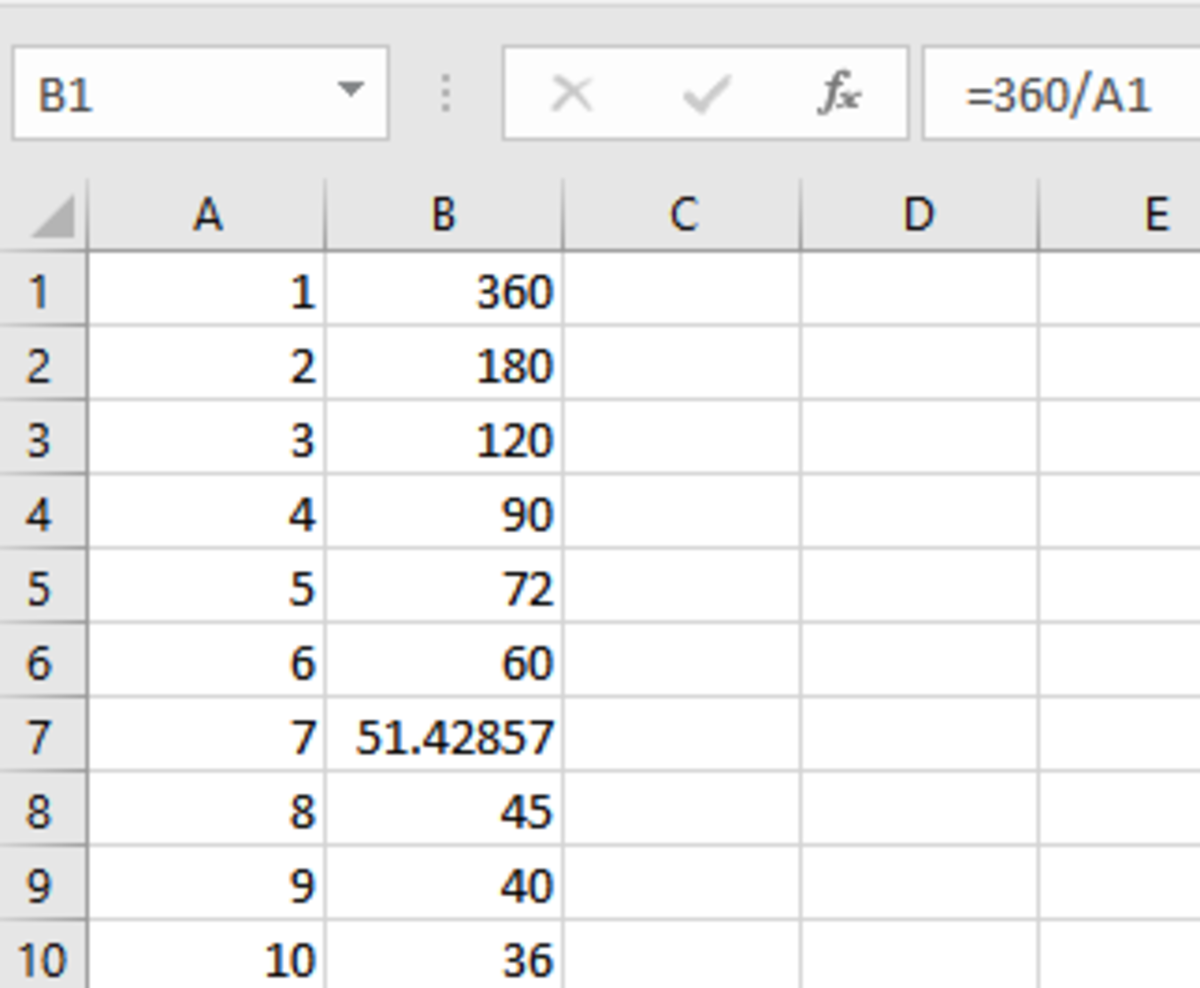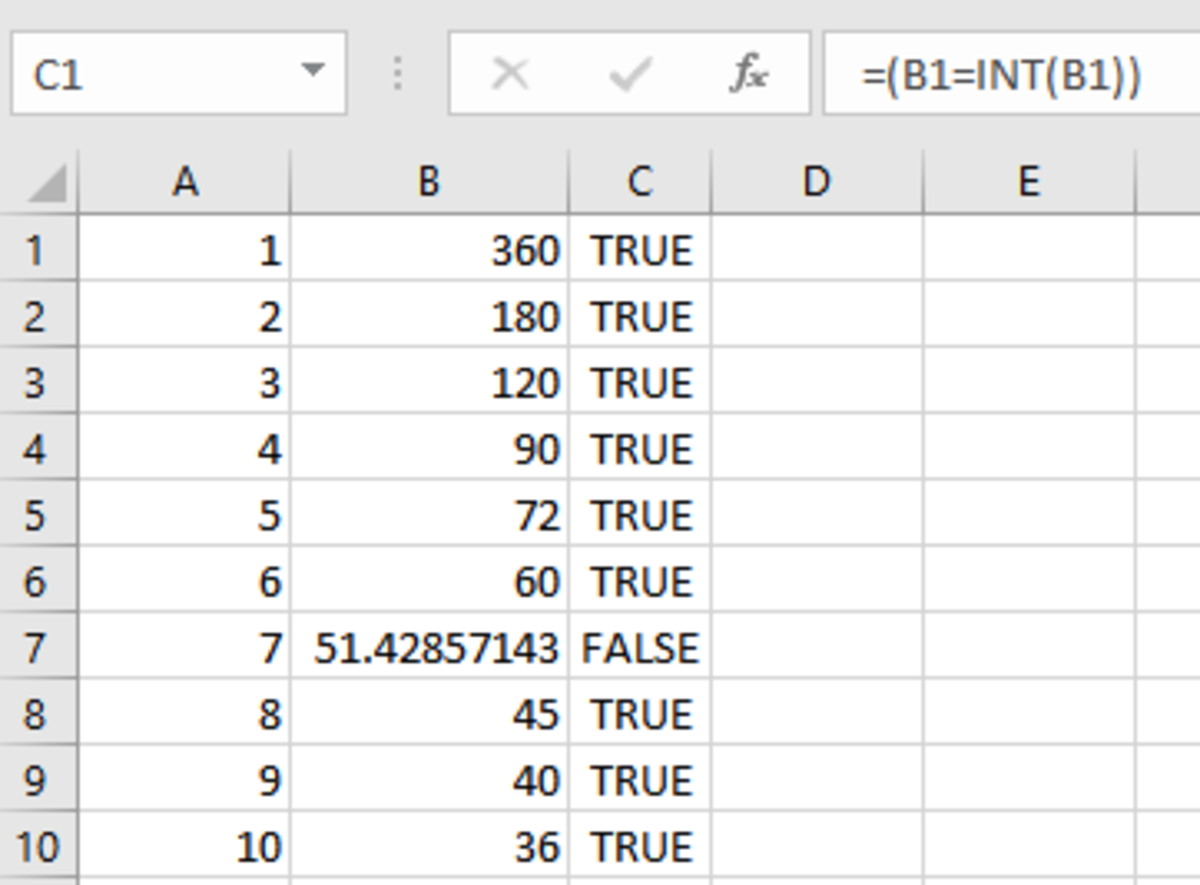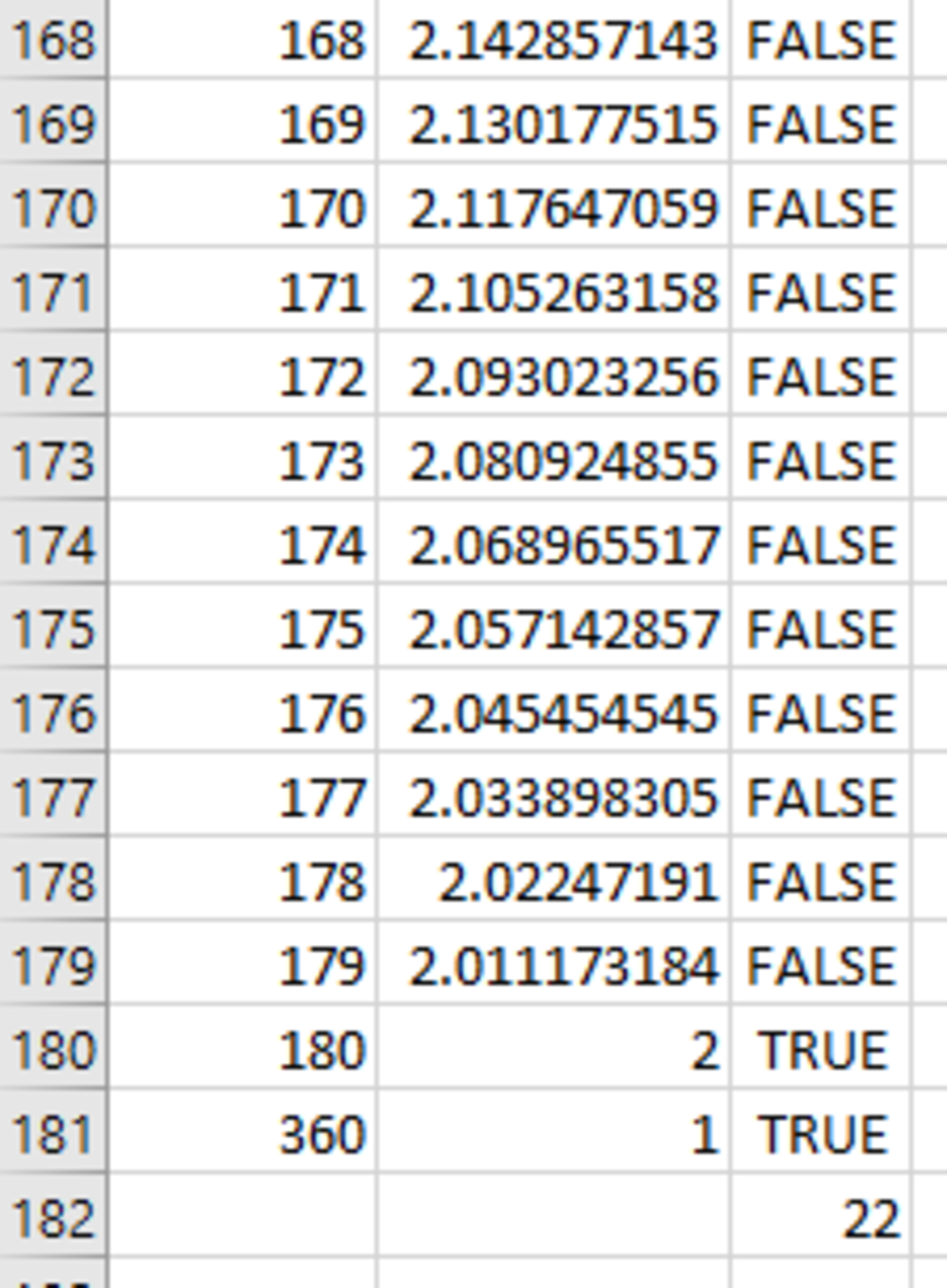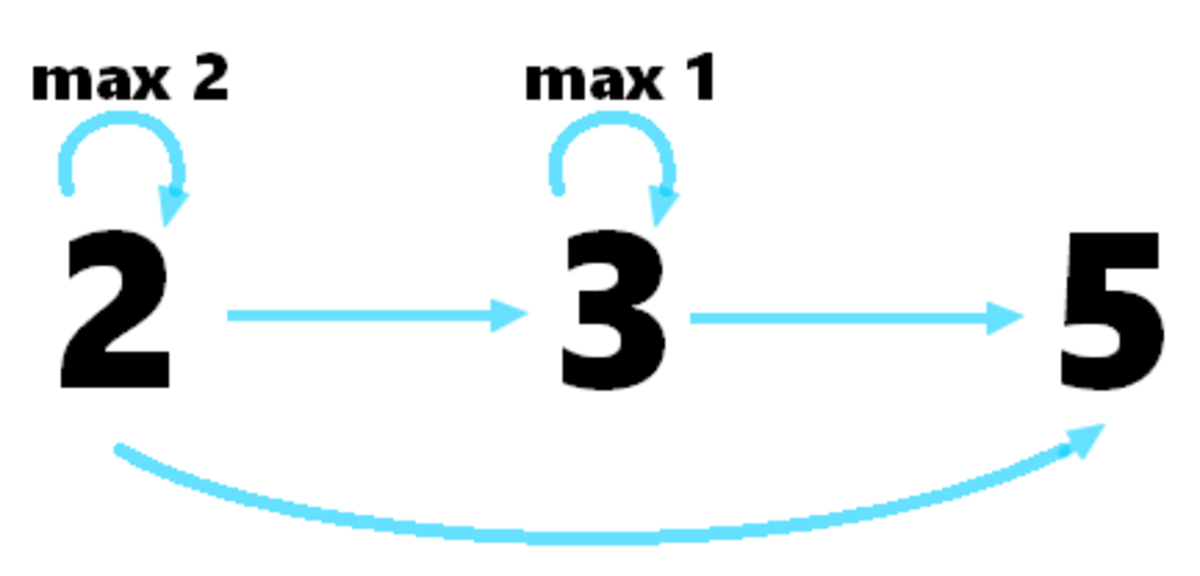Integers Inside
A regular triangle, regular quadrilateral, regular pentagon, and regular hexagon each have interior angles measured in integer degrees.
In total, how many types of regular polygons have interior angles measured in integer degrees?
This section requires Javascript.
You are seeing this because something didn't load right. We suggest you, (a) try
refreshing the page, (b) enabling javascript if it is disabled on your browser and,
finally, (c)
loading the
non-javascript version of this page
. We're sorry about the hassle.
15 solutions
Moderator note:
To explain the "number theory magic step" in more detail:
Because 3 6 0 = 2 3 3 2 5 1 , any divisor of 360 must be composed of some number of 2s, 3s, and 5s (possibly 0 for any of these).
This means a divisor can be written in the form 2 x 3 y 5 z where 0 ≤ x ≤ 3 , 0 ≤ y ≤ 2 , and 0 ≤ z ≤ 1 .
We now have a combinatorics problem. We must choose three things. There are 3 + 1 = 4 ways to choose the 2 exponent, 2 + 1 = 3 ways to choose the 3 exponent, and 1 + 1 = 2 ways to choose the 5 exponent. So there are 4 × 3 × 2 = 2 4 divisors total.
Since 1 and 2 are excluded (they don't form polygons) this gives the 22 possible polygons.
For the number theory magic step, I understand like that: since 360=(2^3) x (3^2) x (5^1) I consider as that one of the factor of 360 must be chosen in these 3 sets and multiply together, that is { (2^0), (2^1), (2^2), (2^3) } and { (3^0), (3^1), (3^2) } and { (5^0), (5^1) } and thus it gives 4 3 2=24 ways, deduct by 2 which there is no polygon with 1 or 2 side(s). Thus, the answer gives 22.
Why do you add 1 to find the numer of possible ways?
Log in to reply
You gotta consider the zero exponent. For example, for 2 3 , there are four ways to pick from it, which are 2 0 , 2 1 , 2 2 and 2 3
Why do you subtract 2 after getting the number of possible divisors for 360? EDIT: It's okay, I got it (a polygon can only have more than 3 sides)
Log in to reply
*3 or more ... but yes, I believe you got it.
Log in to reply
Oh yeah, made that typo, thank you.
Generally, it's because the method counts 360 and 1 as divisors as well, you need to "uncount" them.
The use of 360 for degrees in the circle and 60 seconds in the minute and 60 minutes in the hour comes from an ancient civilization. What was it? They used a counting system of base 60 because you can pretty much avoid the use of fractions in numeric problems.
Log in to reply
https://en.wikipedia.org/wiki/Babylonian_mathematics
Very nice solution and explanation! Thanks!
Each interior angle, of a regular polygon is n ( n − 2 ) 1 8 0 .
This value is an integer, so let us assume it to be x .
So, n ( n − 2 ) 1 8 0 = x ⇒ n 1 8 0 n − 3 6 0 = x ⇒ n 1 8 0 n − n 3 6 0 = x ⇒ 1 8 0 − n 3 6 0 = x So, x is an integer only if 3 6 0 divides n . So, n can have the following values: 1 , 2 , 3 , 4 , 5 , 6 , 8 , 9 , 1 0 , 1 2 , 1 5 , 1 8 , 2 0 , 2 4 , 3 0 , 3 6 , 4 0 , 4 5 , 6 0 , 7 2 , 9 0 , 1 2 0 , 1 8 0 and 3 6 0 . A polygon has a minimum of 3 sides. So, 1 and 2 are excluded from the list of solutions, leaving a total of 2 2 polygons.
A quick way to find the number of divisors of 360 is as follows:
determine the prime decomposition: 3 6 0 = 2 3 ⋅ 3 2 ⋅ 5 ;
write down the exponents plus one and multiply: ( 3 + 1 ) ( 2 + 1 ) ( 1 + 1 ) = 4 ⋅ 3 ⋅ 2 = 2 4 . Leaving out the divisors 1 and 2, this leaves 22 values.
1 2 3 4 5 6 7 8 9 10 |
|
1 2 3 4 5 6 7 8 9 10 11 12 13 14 15 16 17 18 19 20 21 22 23 |
|
You would not exclude 1 and 2 because these represent angles. The angles which would be excluded are 360 (no angle, same as zero) and 180 (a line).
Log in to reply
these represent sides not angles. n side, x angle. beside it's impossible to form a polygon with interior angle less than 60 degrees and bigger than 180 degrees.
The total number of possible interior angles (not the degrees) expressed as integers, has to be the same as the number of sides. In terms of angles the 180 & 360 are not counted and correspond to the imaginary numbers of sides 1 & 2. I prefer to visualize the geometric figures as showing the exterior supplementary angles which always add up to 360. As for the "magic trick", it may be obvious to math pros, however, for us amateurs, the reasoning behind adding (1) to the possible powers of the divisor factors is that 2^x can be 2^0, 2^1, 2^2 or 2^3. The ^0 accounts for the +1 in (3+1)(2+1)(1+1).=24. Sorry, not using LaTex code.
I think you wanted to say that x is an integer only if n divides 3 6 0 , not the other way around
If an interior angle of a regular polygon is an integer, then the exterior angle of a regular polygon is also an integer (since both add up to the integer 1 8 0 ° ).
Since each exterior angle is n 3 6 0 , the number of integer solutions would be the number of factors of 3 6 0 that are greater or equal to 3 (since a polygon must have at least 3 sides) which include 3 , 4 , 5 , 6 , 8 , 9 , 1 0 , 1 2 , 1 5 , 1 8 , 2 0 , 2 4 , 3 0 , 3 6 , 4 0 , 4 5 , 6 0 , 7 2 , 9 0 , 1 2 0 , 1 8 0 , and 3 6 0 , for a total of 2 2 .
An interior and exterior angle pair add up to 180 degrees.
Look at all of you with your fancy math. I just took a minute to write a python script to add them all up!
count = 0
for side in range(3,361):
intAngle = 180-360/side
if intAngle == int(intAngle):
count = count + 1
print(count,intAngle)
Must be equal to a number of divisors of 360 minus 2 {including 1 and 2, that not correspond to polygon}, so the correct answer is 22=24-2.
Similar to the solutions that enumerate the possible solutions by hand or with a simple Python program, we could use an Excel spreadsheet.
- Set column A to the sequence of integers 1-360 (set A1=1, A2=2, then select these two cells and extend the sequence down by dragging the fill handle to A360 then releasing).
- Set B1 to the formula =360/A1 then extend that formula down column B to B360.
- Count the values in column B that are integers and subtract 2 (because n=1 and n=2 are not valid regular polygons).
The first 10 rows would look like:

Shortcut--Note that:
- There can be no integer values of 360/n for n between 181 and 359, so you could set column A to 1-180 instead of 1-360 , then add one extra cell (A181) with value 360.
- Instead of counting the integer values you could automate that. One easy way would be:
- Set C1 to formula =(B1=INT(B1)) -- testing whether B1 is an integer.
- Extend the formula in C1 down to C 360 (or C181 if you used the shortcut).
The first 10 rows will now look like:

- In the first cell past the current end of column C data (so either C361 or C182) enter the formula =(COUNTIF(C1:C???,TRUE) where ??? is either 361 or 182.
- If you drag down from C1 to C??? you won't have to enter the range by hand.
- You can include the "- 2" in the formula, so set C361 or C182 to =(COUNTIF(C1:C???,TRUE) - 2) .
The last several rows would now look like:

And the answer is 2 2
1 2 3 4 5 |
|
The interior angles will be integers iff the exterior angles are integers.
The exterior angle of a regular n-gon is n 3 6 0 .
n 3 6 0 is an integer if n is a factor of 360.
360 = 2 3 3 2 5 1 and so has 4 × 3 × 2 = 2 4 factors.
However the factors 1 and 2 do not correspond to polygons (because there are no polygons with only one or only two sides).
And so there are 2 2 polygons with the required property.
Notes
iff is not a spelling mistake. It is usual mathematical shorthand for 'if and only if'.
The 'exterior angle' is the angle found by extending one side and finding the angle between the extended line and the next side of the polygon.
To see that the exterior angle of a regular polygon is n 3 6 0 , hold your pen along one side of the polygon. Always rotating in the same direction, rotate your pen through one exterior angle so that it lines up with the next side. Repeat this so that your pen lines up successively with all n sides of the polygon and returns to its starting position. You will find that it has turned through n exterior angles and made one full revolution of 360 degrees! This holds for any convex polygon, regular or not. For regular polygons we know that each exterior angle is equal, and so each one must be n 3 6 0 as claimed. I highly recommend trying out the pen rotation proof on the diagrams provided in the question - it is very satisfying and totally convincing.
I used a quick way to find the number of factors of a number. Factorise the number as powers of prime numbers. Add one to each of the exponents. Then multiply the resulting numbers.
I like the pen rotation idea.
Minimal modication of the standard solution: If the internal angle is of a n-polygon is given by 1 8 0 ( n − 2 ) / n is to be an integer there must exist some integer k such that n 1 8 0 ( n − 2 ) = k and this can be rearranged into 1 8 0 ( n − 2 ) = k n
1 8 0 n − 3 6 0 = k n
and finally
( 1 8 0 − k ) n = 3 6 0
I think this form more directly exposes to me that solutions (n,k) cossespond to different ways of factoring 360.
For example the product 4 ⋅ 9 0 = 3 6 0 corresponds to the solution k = 1 7 4 , n = 9 0 which corresponds to the 90-sided polygon.
So we count the different ways of factoring 360 by the divisor-counter function
τ ( 3 6 0 ) = τ ( 2 3 ⋅ 3 2 ⋅ 5 ) = ( 3 + 1 ) ( 2 + 1 ) ( 1 + 1 ) = 2 4
but then we have to discard the products
3 6 0 ⋅ 1 = 3 6 0 and 1 8 0 ⋅ 2 = 3 6 0
as n = 1 and n = 2 do not correspond to actual polygons.
24 - 2 = 22
1 2 3 4 5 |
|
This gives 22.
For those who like a more graphical solution:

This is a directed graph with each node one of the primes when factorizing 360: 2 3 ∗ 3 2 ∗ 5 . Now, starting at any node, count the paths of any length (min = 1, max = 5). You'll count a total of 20. Finally, add 3 and 5 as a solution too (2 isn't because we need at least 3 sides) and you'll end up with 22 solutions.
It's not a mathematical solution, but quite intuitive to understand the problem
You can list those polygons and their interior angles in Python like that:
for n in range(3, 1000):
a = (n - 2) * 180 / n
if float(a).is_integer():
print("{} sides -- {}°".format(n, a))
Or short:
len([n for n in range(3, 1000) if float((n - 2) * 180 / n).is_integer()])
n = 20 does not give a 20-gon. any n greater than 20 gives negative angles and builds the same polygons. The correct answer is 11 polygons
How do we get negative angles?
 Dismantling the Privilege of the Mathematical 1% - http://blog.mrmeyer.com/
Dismantling the Privilege of the Mathematical 1% - http://blog.mrmeyer.com/
check when the modulo of an integer and 360 equals 0 (i mod 360 == 0) and count for how many i’s this is the case. The answer is 22.
I think you meant (360 mod i == 0), not (i mod 360 == 0)/
For all these shapes the size of each interior angle, i, times the number of angles, n gives you 360, i*n=360. This means we just have to look at all the factors of 360, obviously we have to discount a 1 or 2 sided shape, so the answer is the number of factors of 360, minus 2
That's only true for the square (and convex quadrilaterals), because for the other shapes, i × n = 180(n-2).
360 has 22 divisors: 1,2,3,4,5,6,8,9,10,12,15,18,20,24,30,36,40,45,60,72,90,120,180, and 360.
Therefore, there are 22 regular shapes whose interior angles will divide 360 degrees evenly.
Unfortunately you have listed 24 divisors!
Log in to reply
You can't have 1 or 2 sides in a polygon...
A regular n-gon has an interior angle of
n 1 8 0 ( n − 2 ) .
Rearranging, we get
1 8 0 − n 3 6 0
We have to know how many integers divide into 360, subtract it by two (because there are no polygons with 1 or 2 sides), and we get our answer
Number theory magic:
3 6 0 = 2 3 3 2 5 1
therefore 3 6 0 has
( 3 + 1 ) ( 2 + 1 ) ( 1 + 1 ) = 4 ⋅ 3 ⋅ 2 = 2 4 divisors
subtract two, we get 2 2 :D